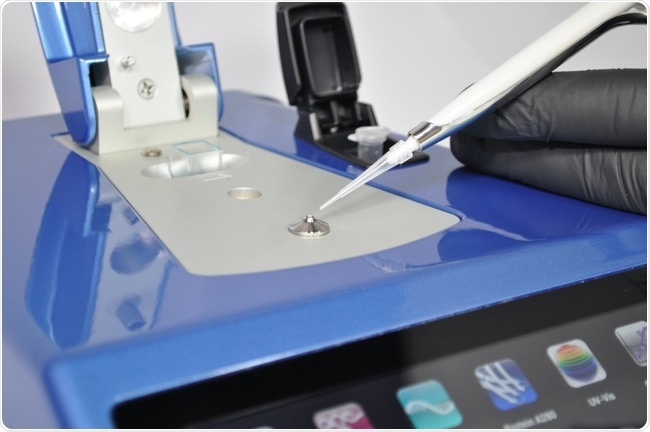One widely used technique in cellular and molecular biology is fluorescence microscopy, which is employed both to observe the interactions between various components of an organism and for spatial analysis.

Image Credit: DeNovix Inc.
Fluorescence quantification can take place by using the light intensities of each pixel of the detector (e.g., CCD, CMOS) to extract numeric data from images, although fluorescent imaging micrographs are usually qualitative.
This article will explore some common scenarios in which fluorescence quantification is used. First, some general uses will be explored before focusing on key applications of DeNovix fluorescence quantification solutions.
Fluorescence quantification for cancer diagnosis
Human tissues can be used with fluorescence quantification. Frequently, early tumors grow on tissues with fast regeneration and turnover of cells, as with transformed mucosa on the surface of hollow organs, for example. Near real-time diagnoses can be made without adverse side effects with fluorescence quantification.
One way fluorescence quantification is used for cancer diagnoses includes administering a drug like a hematoporphyrin derivative (HpD), which is selectively retained by the tumor. The drug, which has been localized in the tumor, fluoresces when the mixture is excited with light of a specific wavelength. This is used for the detection and imaging of tumors.
Fluorescence quantification for studying of marine petroleum pollutants
Another use of fluorescence quantification is to detect oil slicks on the surface of water. Specifically, it can be used to identify specific petroleum derivative compounds and for determining their sources.
The key component of oils is hydrocarbon, and the other components are derivatives of hydrocarbons that are made up of single atoms of nitrogen, oxygen and sulfur.
However, only some of these hydrocarbons fluoresce, and many of them appear to have no ability to luminescence a tall. Petroleum strongly absorbs radiation, especially blue light and ultraviolet.
However, petroleum is a luminescent medium, which means that it is possible to use fluorescence quantification to test oils. Oil fluorescence typically covers a spectral area in the visible and ultraviolet and range. The 270-400 nm range is where the phenomenon is most significant.
Fluorescence quantification for the determination of glucose
Glucose is an important element of plant and animal carbohydrates within biological systems. Another significant element when determining human health conditions is blood glucose level.
Critical health information regarding diseases like hypoglycemia or diabetes can be provided by information about abnormal levels of glucose in the blood. Fluorescence quantification is highly sensitive and simple, making it ideal for determining levels of glucose.
A novel fluorescence probe for selective and sensitive detection of glucose has been shown to be bio-molecule stabilized Au nanoclusters.
Fluorescence quantification solutions from DeNovix
CellDrop Automated Cell Counters
Patented DirectPipette™ Technology is used by CellDrop Automated Cell Counters to Count Cells Without Slides. This eliminates the need for inconvenient hemocytometers or plastic consumables when completing routine cell counting.
CellDrop Cell Counters use a unique, variable height sample chamber, brightfield optics and dual fluorescence and have easy-to-use analysis software that can simplify the automation of routine cell counting.
The automated cell counters can be used in a wide range of life science applications, but when used in fluorescence mode, the CellDrop is particularly well-suited to the study of primary cells. This is because it can test transfection efficiency, identify isolated nuclei or nucleated cells, assess cell viability and more.
Eliminate Costs | Automate Cell Counting
DS-11 Series spectrophotometer / fluorometer
The DS-11 Series is a compact and simple to use instrument and offers full-spectrum microvolume and cuvette UV-Vis analysis. It also has fluorescence capability integrated into the same instrument.
This instrument is also ideal if a lab requires rapid protein and nucleic acid-protein quantification with sample quality control.
The DS-11 Series has an industry-leading lower detection limit of 0.04 mg/mL BSA, 0.60 ng/uL RNA, or 0.75 ng/uL dsDNA, and is able to measure samples with absorbance values at as much as 750 absorbance units (at a 1 cm equivalent path length). This means there is an upper detection limit of 37500 ng/uL of dsDNA or 1125 mg/ml of BSA protein.
DS 11 Series | Spectrophotometer | Fluorometer
About DeNovix, Inc.
WELCOME TO DENOVIX
Award-Winning products for Life Science
Our multi-award winning products include the Reviewers’ Choice Life Science Product of the Year and Platinum Seal awarded- DS-11 Series Spectrophotometer / Fluorometer and CellDrop™ Automated Cell Counter. CellDrop is the first instrument of its kind to Count Cells Without Slides. These powerful instruments integrate patented DeNovix technology with easy-to-use software designed by life scientists for life scientists.
Researchers tell us they love the industry leading performance, smart-phone-like operation, and the flexible connectivity of the instruments. When support is needed, the DeNovix team is here to help. DeNovix received the prestigious Life Sciences Customer Service of the Year based on independent reviews posted by scientists worldwide!
CellDrop: Sustainable laboratory product of the year
The CellDrop Automated Cell Counter has been awarded Sustainable Laboratory Product of the Year in the SelectScience® Scientists’ Choice Awards®!
CellDrop’s patented DirectPipette™ technology distinguishes it as the only cell counter to eliminate the need for cell counting slides. This innovation saves millions of single-use plastic slides from use and disposal each year.
Sponsored Content Policy: News-Medical.net publishes articles and related content that may be derived from sources where we have existing commercial relationships, provided such content adds value to the core editorial ethos of News-Medical.Net which is to educate and inform site visitors interested in medical research, science, medical devices and treatments.